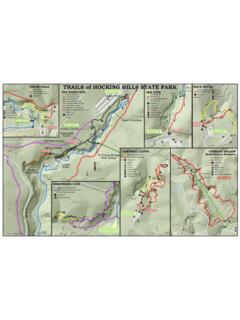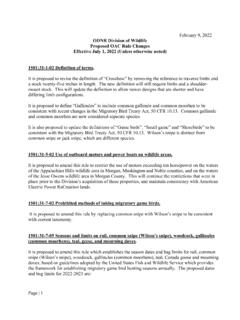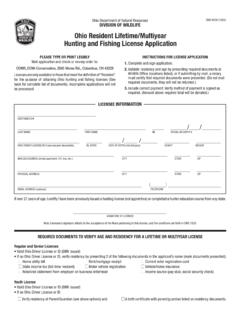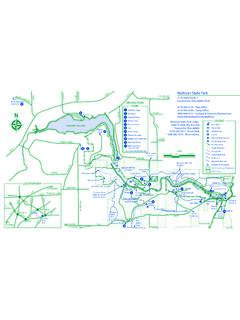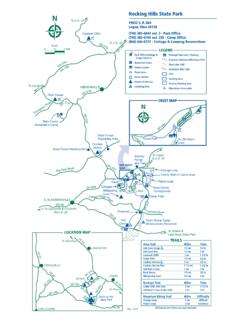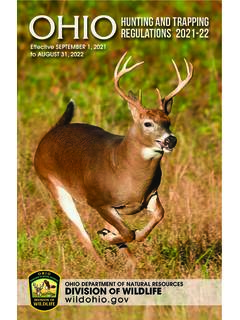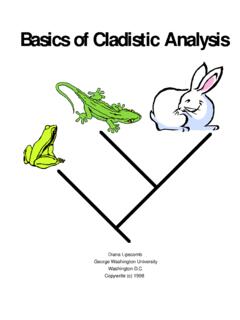Transcription of TREES OF OHIO field guide
1 TREES OF OHIO field guideDIVISION OF WILDLIFEINTRODUCTIONF orests in Ohio are diverse, with 99 different tree spe-cies documented. This field guide covers 69 of the species you are most likely to encounter across the state. We hope that this guide will help you appre-ciate this incredible part of Ohio s natural resources. TREES are a magnificent living resource. They provide shade, beauty, clean air and water, good soil, as well as shelter and food for wildlife. They also provide us with products we use every day, from firewood, lum-ber, and paper, to food items such as walnuts and maple syrup. The forest products industry generates $ billion in economic activity in Ohio; however, TREES contribute to much more than our economic well-being. The more we learn about TREES , the more we can un-derstand, protect, and enjoy booklet is produced by the ODNR Division of Wildlife as a free publication. This booklet is not for resale.
2 Any unauthorized reproduction is pro-hibited. All images within this booklet are copyrighted by the ODNR Division of Wildlife and its contributing artists and photographers. For additional information, please call 1-800-WILDLIFE (1-800-945-3543).HOW TO USE THIS BOOKLET8 FAMILYDECIDUOUSK nown for its spreading canopy and distinctive smooth bark, American beech is a slow-growing tree found throughout the state. It is an excellent wildlife tree . Beech nuts are high in protein and fat and eaten by many birds and mammals. Furthermore, many beech tree trunks are partially hollow and provide excellent den sites for various wildlife, including squirrels, rac-coons, and opossums. This native tree can adapt to soils of variable pH and composition but prefers rich, well-drained soils with constant moisture. While Amer-ican beech is shade tolerant, it achieves best growth in partial to full sunlight.
3 It is usually long-lived and free of problems, but can be susceptible to beech bark disease, beech leaf disease, and storm damage. LEAF: Alternate and simple with coarse serrations on their slightly undulating margins, 2-4 inches long. Fall color from yellow-green to a rich golden-brown; older TREES hold dead leaves throughout winter on lower, inte-rior branches while young TREES hold virtually all of their dead leaves until spring (making them stand out in the woods in the winter). TWIGS AND BUDS: Buds are long ( to 1 inch), narrow, pointed, occurring on outer OR SEED: Fruits are composed of an outer prickly husk that splits open in late summer and early autumn to reveal one or two triangular, edible nuts enjoyed by birds and mammals alike. Beech nuts are known as an excellent food source for wildlife, high in fat and protein and produced in large : Smooth, thin, light to steel gray, that is common-ly carved with initials and graffiti and holds carvings for decades.
4 Carvings create wounds for disease entry, so please respect the tree !SHAPE: Short trunk, rounded to HEIGHT: 60-80 BEECH Fagus grandifoliaBEECHC ommon nameScientific nameFamily nameOverviewTREES OF OHIO TABLE OF CONTENTS02 Introduction04 History of Ohio's Forests05 Importance of Trees06 Broadleaf Types07 Leaves and Limbs08 Species Accounts77 Glossary79 Publication FundingDECIDUOUS TREESBEECH FAMILY 8 American Beech 9 American Chestnut 10 Black Oak 11 Bur Oak 12 Chestnut Oak 13 Chinkapin Oak 14 Northern Red Oak 15 Pin Oak 16 Scarlet Oak 17 Shingle Oak 18 Shumard Oak 19 Swamp White Oak 20 White OakBEAN FAMILY 21 Black Locust 22 Honeylocust 23 Kentucky CoffeetreeBIGNONIA FAMILY 24 Northern Catalpa BIRCH FAMILY 25 Black Birch 26 River Birch 27 Yellow BirchELM FAMILY 28 Hackberry 29 American Elm 30 Slippery ElmEBONY FAMILY 31 PersimmonHORSECHESTNUT FAMILY 32 Ohio Buckeye 33 Yellow BuckeyeLAUREL FAMILY 34 SassafrasLINDEN FAMILY 35 American BasswoodMAGNOLIA FAMILY 36 Cucumbertree 37 Yellow PoplarMAPLE FAMILY 38 Boxelder
5 39 Red Maple 40 Silver Maple 41 Sugar Maple MULBERRY FAMILY 42 Osage Orange 43 Red MulberryOLIVE FAMILY 44 Green Ash 45 White AshPLANE tree FAMILY 46 American SycamoreROSE FAMILY 47 Black Cherry TUPELO FAMILY 48 BlackgumWALNUT FAMILY 49 Butternut 50 Black Walnut 51 Bitternut Hickory 52 Mockernut Hickory 53 Pignut Hickory 54 Shagbark Hickory 55 Shellbark HickoryWILLOW FAMILY 56 Bigtooth Aspen 57 Black Willow 58 Eastern CottonwoodWITCHHAZEL FAMILY 59 SweetgumCONIFER TREESPINE FAMILY 60 Colorado Blue Spruce 61 Norway Spruce 62 Eastern Hemlock 63 Austrian Pine 64 Eastern White Pine 65 Loblolly Pine 66 Pitch Pine 67 Red Pine 68 Scotch Pine 69 Shortleaf Pine 70 Virgina PineCYPRESS FAMILY 71 Eastern RedcedarINVASIVE TREES 72 Callery Pear 73 Sawtooth Oak 74 Siberian Elm 75 tree -of-Heaven 76 White MulberrySPECIES ACCOUNTSP rior to European settlement when Ohio s forests covered 95 percent of the state, it was said that a squirrel could travel from one corner of the state to the other without touching the ground.
6 While that may be an exaggeration, forests of many types were abundant through-out the state. Elm-ash forests were dominant in the northwest Ohio swamp lands and streamside areas; mixed oak-hickory forests domi-nated the southeast Ohio hill country, and maple-beech forests were common in northeast Ohio and much of Ohio s current farm country. With the historical clearing of forestland followed by natural conver-sion of old fields back to woods, oak-hickory forests likely expanded their distribution. Currently oak-hickory forests are the most common forest type in the state at around 63 percent of all forests. A broader northern hardwood forest type that includes maple and beech is next in abundance, covering around 20 percent of Ohio s forestland. Elm-ash forests are still common in northwest Ohio and along streamside areas. However, with the introduction of the exotic beetle called the emerald ash borer into Ohio in 2003, most of Ohio s mature ash TREES are dead or dying.
7 The total area of forest land in the state has stabi-lized in the past two decades at around 30 percent of the total land area. The majority of forests are in the mid-successional stage and are dominated by TREES that are often over a foot in diameter and 50 to 90 years clearing of forests occurred until the 1940s when only 12 percent of the land remained forested. Forest land has expanded to current conditions, where 31 percent of Ohio s land area is covered by forests. THE HISTORY OF OHIO'S FORESTSV irigina-Pitch PineOak-PineOak-HickoryOak-GumElm-Ash-Re d MapleMaple-Beech-BirchOpen or mixed land coverSUCCESSIONAL FORESTSMany wildlife species are reliant on forests to provide the basic habitat requirements of food, water, shelter, and space. Different species of wildlife require diverse habitat components and are dependent on various stages of forest succession, or ages, to meet their spe-cific needs.
8 Forests grow as plants develop and age towards maturity, and each state of succession offers different habitat assets. The early stages of a forest's life are just as important as the later stages, and pro-vide much needed diversity in people believe that older forests provide en-hanced habitat opportunities for wildlife, and that the highest diversity of species would be found in these areas. While it s true that mature forests are home to many species, a variety of forest age-classes will do more to attract a wider diversity of successional, or young, forests produce an abun-dance of fruits and seeds, and provide shrub thickets for cover which attracts species such us common yel-lowthroats, eastern towhees, and bobcats. Mid-suc-cessional, or mid-aged, forests support species that use a wide range of habitats such us wild turkeys, indigo buntings, and white-tailed deer. Mature, or older, forests produce more acorns and nuts and pro-vide snags and tree cavities for nesting which attracts species such us flying squirrels, pileated woodpeck-ers, and silver-haired bats.
9 Even open areas with little woody vegetation produce seeds and insects for wild-life and provide herbaceous food and cover which at-tracts species such us eastern cottontail rabbits, field sparrows, and prairie ARE TREES IMPORTANT FOR WILDLIFE?THE IMPORTANCE OF MASTMast is a term used to describe the fruit of a woody plant. The fruit is the part of the tree that contain the seeds and protects them until they can sprout in the ground. These fruits are categorized as either hard mast or soft mast. Hard mast are seeds with a hard outer covering, such as acorns, hickory nuts, and walnuts. Hard mast is an important food source for wildlife because it does not decay quickly, thus providing animals with nutrition throughout the winter. It is a good source of protein and fat which are important nutritional components. TREES require a large amount of energy to create hard mast, so they generally only produce a substantial crop every few years.
10 Many wildlife species consume acorns, including some you might not think of, such as foxes and ducks. Oak-hickory forest is the most wide-spread forest type in Ohio and is an important habitat in the eastern However, poor oak regeneration in recent years is a cause for concern. tree species such as maple, poplar, and beech are in-creasing in abundance. These species grow faster than oaks and do not require as much sunlight, shading out smaller TREES . Maples and poplars produce a fruit that is classified as soft mast, meaning it has a soft outer covering and decays quickly. It is usually high in sugar and carbohydrates which are not as important nutri-tionally. This makes it an unreliable food source during the winter, but it does serve as a good short-term en-ergy source for migrating wildlife that pass through Ohio. TREES don t use as much energy to produce soft mast, so it is more readily abundant every NINA HARFMANNCOMPOUNDSIMPLESIMPLECOMPOUNDPINN ATEH ickory, Walnut, Black LocustBIPINNATEH oneylocust, Kentucky CoffeetreeLOBEDM aplePALMATEB uckeyePINNATEAsh, Boxelder, tree -of-HeavenALTERNATEOPPOSITE WHORLEDC atalpaSIMPLEBROADLOBEDY ellow Poplar, Sassafras, Sycamore, SweetgumNOT LOBEDA spen, Basswood, Cottonwood, Mulberry, Callery PearLONGER THAN WIDESMOOTHB lackgum, PersimmonCucumbertreeTOOTHEDB eech, Chestnut, Hackberry, Elm, Birch, Black Cherry, WillowLOBEDOaksSMOOTHO sage OrangeBROADLEAFBROADLEAF TYPESOne of the most important tree identification concepts is leaf and branch arrangement.

